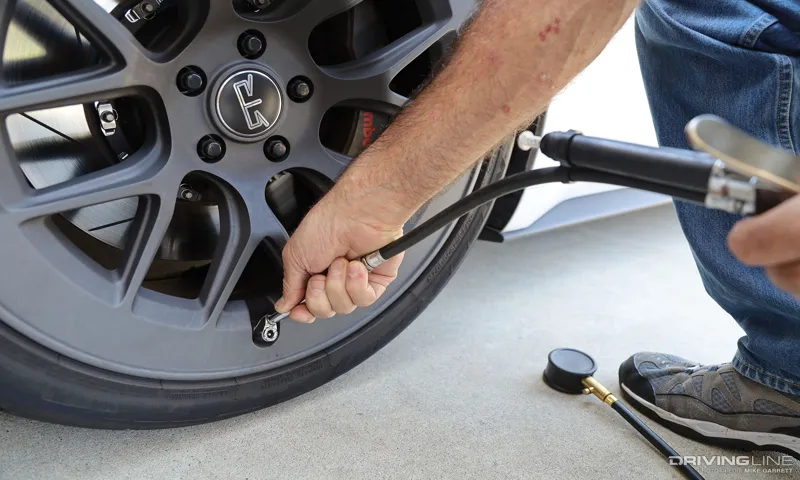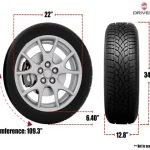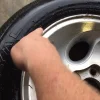It can be incredibly frustrating and unnerving to experience a flat tire while driving on the road. That’s why most drivers make sure to have a spare tire in their trunk as a backup plan. However, it’s essential to know how much air to put in a spare tire to ensure your safety on the road.
The amount of air needed in a spare tire can vary by vehicle and tire model. Generally, you should aim to inflate the spare tire to the maximum PSI (pounds per square inch) recommended by the manufacturer. This information can be found on the side of the tire or in the owner’s manual.
It’s crucial to note that while a spare tire may be a temporary solution, it’s still imperative to have it filled with the correct amount of air. Overinflating or underinflating the tire can lead to additional problems and even result in a blowout on the road. Ultimately, it’s always best to be prepared for potential mishaps on the road.
By knowing how much air to put in a spare tire and ensuring that it’s properly inflated, you can travel safely and with peace of mind knowing you have a reliable backup plan should the unexpected occur.
Table of Contents
Understanding the Basics of Spare Tires
When it comes to spare tires, understanding how much air to put in is key. The spare tire is meant to be a temporary solution and typically has a recommended pressure range printed on the tire itself or within the vehicle’s manual. It is important to check and maintain the spare tire’s pressure just as you would with the regular tires.
Overinflated tires can be just as dangerous as underinflated ones, causing handling issues and increasing the risk of a blowout. Plus, an underinflated spare tire may not be able to support the weight of your vehicle properly. So remember to check your spare tire’s pressure and ensure it is within the recommended range to ensure a safe and reliable backup option in case of a flat tire on the road.
Why You Need to Check Your Spare Tire Pressure?
Spare Tire Pressure Spare tires are often overlooked until the moment we need them most. However, it is crucial to maintain their pressure levels to ensure they are ready for use in emergency situations. Keeping a spare tire with the proper pressure will allow it to function correctly and safely.
It is recommended to check the pressure of your spare tire at the same time as your regular tires, every month or before going on a long trip. Neglecting the spare tire can lead to problems, such as an inability to mount the tire properly or cause it to wear down prematurely. Additionally, low tire pressure can also affect your vehicle’s handling and fuel economy.
Therefore, it is essential to include your spare tire in your regular tire maintenance routine. Remember, when you have a flat tire, it’s not the time to realize that your spare tire is unusable due to low pressure. By keeping your spare tire ready to use, you can ensure you’re always prepared for any unforeseen circumstances on the road.

What is the Recommended Air Pressure for a Spare Tire?
As a driver, it’s crucial to understand the basics of spare tires. Whether you have a flat tire or need to change your car’s wheels for maintenance purposes, knowing the recommended air pressure for your spare tire is essential. In general, the recommended air pressure for a spare tire is 60 PSI, but it’s always wise to check your car’s owner’s manual to ensure the correct tire pressure.
Keeping your spare tire at the recommended air pressure will ensure that it’s in optimal condition and ready to use when you need it. Just like your regular tires, underinflated spare tires can lead to lower fuel efficiency and increased wear and tear on the tire itself. So, don’t forget to periodically check your spare tire’s air pressure to ensure that it’s always in good shape.
After all, it’s better to have a well-maintained spare tire on hand when you need it than to be caught unprepared on the road.
How to Check and Inflate Your Spare Tire?
When it comes to your spare tire, it’s essential to make sure it’s always in good working condition. The last thing you need is to have a flat tire and then find out that your spare tire is flat too! So, how much air should you put in your spare tire? The answer is pretty simple. The recommended pressure for most spare tires is between 60-80 psi.
To check the pressure, you need a tire gauge, which you can usually find at any auto parts store. Remove the spare tire from your vehicle and make sure it’s on a level surface before checking the pressure. If the pressure is low, inflate it to the recommended level.
If you’re not sure how to inflate your tire, refer to the instruction manual that came with your vehicle. Remember that it’s crucial to check your spare tire’s pressure periodically, especially before long trips. That way, you can be sure it won’t let you down when you need it most.
Step 1: Locate Your Spare Tire
Checking and inflating your spare tire can save you from being stranded on the side of the road when you need it most. But before you can check its pressure, you first need to locate it. The spare tire is usually located in the trunk of most cars or underneath the vehicle.
If you’re unsure where your spare tire is located, check your car manual for instructions. Once you’ve identified its location, you can then proceed to check its air pressure. Remember to use a tire gauge for accurate readings, as underinflated or overinflated tires can be dangerous and lead to tire damage.
By regularly checking and inflating your spare tire, you can ensure your safety on the road and avoid unnecessary stress.
Step 2: Check the Manufacturer’s Recommendation
When it comes to checking and inflating your spare tire, it’s important to follow the manufacturer’s recommendation. Before doing anything, you’ll want to check the manufacturer’s recommendation sticker that’s located on the spare tire to find out what the recommended tire pressure is. The recommended tire pressure is usually also included in the owner’s manual that came with your vehicle.
Once you have that information, you’ll want to use a tire gauge to check your spare tire’s current tire pressure. If the tire pressure is low, you’ll want to inflate the tire until it reaches the recommended tire pressure. Overinflating your spare tire can be just as bad as underinflating it, so be careful not to overdo it.
By following the manufacturer’s recommendation, you can ensure that your spare tire is in good condition and ready for use in case of an emergency.
Step 3: Check the Current Air Pressure
When it comes to maintaining your vehicle, it is essential to keep an eye on your spare tire’s air pressure. It might be easy to forget about it, but it can save your day in an emergency. To check your spare tire’s air pressure, you will need a tire pressure gauge.
First, you must locate the spare tire, which is usually kept in the trunk of the vehicle. Then, unscrew the valve stem cap and attach the pressure gauge. Press the gauge firmly, and the measurement will appear on the device’s scale.
If the air pressure is below the recommended pressure, then it is time to inflate the tire. You can use either a portable air compressor or visit a nearby gas station to do the same. Remember to check the air pressure regularly and inflate if necessary to keep your spare tire ready to use in the event of a flat tire on the road.
Step 4: Inflate the Tire if Needed
When it comes to checking and inflating your spare tire, it’s important to take the time to ensure it’s ready for use in case of an emergency. Begin by inspecting the tire for any signs of damage or wear, such as cuts or bulges on the sidewall. If the tire appears to be in good condition, use a tire pressure gauge to check the air pressure.
The recommended pressure can be found in your vehicle’s owner’s manual or on a sticker located inside the driver’s side door. If the pressure is low, use an air compressor or a tire inflator to add air until the proper pressure is reached. It’s important not to overinflate the tire, as this can cause it to burst or become unstable while driving.
Once the tire is properly inflated, be sure to store it in a safe place in your vehicle, such as the trunk or cargo area, and to replace any damaged tires as soon as possible. By taking the time to check and inflate your spare tire, you’ll be better prepared for unexpected flat tires or blowouts on the road.
Tips for Maintaining Your Spare Tire
When it comes to your spare tire, it’s essential to make sure it’s always ready to use in case of an emergency. One of the most critical factors in maintaining your spare tire is ensuring it has the correct air pressure. The recommended air pressure for your spare tire is usually located on a sticker or in your owner’s manual.
It’s important to keep in mind that the air pressure for your spare tire may differ from the pressure needed for your regular tires. You should check the air pressure in your spare tire regularly, especially before long road trips or if your car has been sitting unused for an extended period. If your spare tire is underinflated or overinflated, it can affect its ability to perform correctly.
So, how much air do you put in a spare tire? The answer varies depending on the make and model of your vehicle, so make sure to double-check the recommended air pressure before filling your spare tire. By maintaining the right air pressure and keeping your spare tire in good condition, you’ll be ready to hit the road with confidence.
Check Your Spare Tire Regularly
It’s easy to forget about your spare tire until you need it, but keeping it in good condition is crucial for your safety on the road. Here are some tips for maintaining your spare tire: Regularly check the pressure – just like your other tires, your spare can lose air over time, so make sure to check and adjust the pressure as needed.
Inspect for damage – even if you haven’t used your spare, it can still suffer wear and tear from exposure to the elements. Make sure to inspect it occasionally for any cracks, cuts, or other damage that could compromise its integrity.
Rotate it in with your other tires – if you have a full-size spare, consider rotating it in with your other tires to help distribute the wear more evenly. Remember, your spare tire is there for emergencies, so take care of it and it will take care of you.
And in case you need it, always keep a jack and lug wrench in your vehicle too.
Replace Your Spare Tire When Necessary
One thing that’s often overlooked when it comes to maintaining a vehicle is the spare tire. It’s easy to assume that since it’s not used regularly, it doesn’t need to be replaced as often as the other tires. However, the truth is that spare tires have a shelf life and should be replaced every six years or so, even if they haven’t been used.
The reason for this is that spare tires are typically made with a different type of rubber than regular tires, which means they deteriorate over time. If you’re not sure how old your spare tire is, check the sidewall for a date stamp. If it’s been more than six years since the tire was manufactured, it’s time to replace it.
It’s also a good idea to regularly check the spare tire’s pressure and ensure it’s inflated to the correct level. Make sure you have all the necessary tools to change a tire, including a jack and lug wrench. Remember, if you do need to use your spare tire, it’s not a permanent replacement for your regular tires.
Get the damaged tire repaired or replaced as soon as possible to ensure safe driving. By taking care of your spare tire, you can be prepared for any unexpected flat tire situations.
Conclusion
In conclusion, the amount of air you put in a spare tire ultimately depends on the make and model of your vehicle. However, we can all agree that putting too little or too much air will leave you stranded on the side of the road with a flat spare tire. So, let’s make sure to add just the right amount of air – enough to get you safely to the nearest service station but not so much that you’re rolling on a balloon.
Remember, a spare tire may be temporary, but bad tire maintenance is a long-term problem.”
FAQs
What is the recommended pressure for a spare tire?
The recommended pressure for a spare tire is typically listed on the sidewall of the tire itself or in your vehicle’s owner’s manual. It is typically around 60 PSI.
Is it safe to drive on a spare tire for an extended period of time?
Spare tires are intended to be temporary solutions and should not be driven on for long periods of time or at high speeds. They are designed to get you to a repair shop to get a new tire, not to be a permanent substitute.
Can you use a different size tire as a spare tire?
It is not recommended to use a different size tire as a spare tire unless it is a temporary emergency situation. Using a tire that is a different size or type than your vehicle’s other tires can cause handling issues and potentially damage your vehicle.
Do all cars come with a spare tire?
Not all cars come with a spare tire. Some use run-flat tires or have a tire repair kit instead.
How often should you check the air pressure in your spare tire?
It is recommended to check the air pressure in your spare tire at least once a month to ensure that it is ready to use in case of an emergency.
Can you repair a punctured spare tire?
It is possible to repair a punctured spare tire, but it is generally not recommended. Spare tires are older and often not in the best condition, so it may be safer to replace the tire altogether.
What is the maximum distance you can drive on a spare tire?
There is no set maximum distance you can or should drive on a spare tire. It is recommended to get a new tire as soon as possible and avoid driving on the spare tire for an extended period of time.



